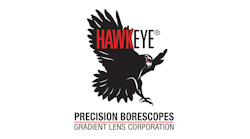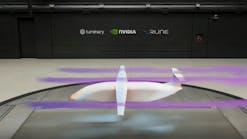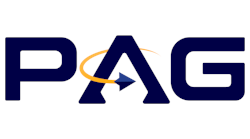"The Big Five"
By Joseph Stump
Nondestructive inspection (NDI) in the field of aviation came into its own in the 1940s. While still in its infancy, it represented a major innovation in aircraft maintenance and inspection technology. Nondestructive inspection implies a method that will detect "defective" parts and assemblies while avoiding any damage to serviceable items during the course of the inspection process.
NDI has grown exponentially over the past 25 years in both application and innovation. It has done more to improve safety than just about any other existing technology.
This article will provide a general overview, "The Big Five," of NDI. These are the core disciplines that represent the bulwark of the aircraft maintenance and manufacturing industries.
1. Fluorescent penetrant testing
This is a nondestructive testing method best suited for finding discontinuities open to the surface in solid materials that are essentially nonporous. Penetrants are low viscosity liquids specifically engineered to seep into the tightest flaws and hairline fractures by way of capillary action. The penetrant contains a fluorescent compound that illuminates when exposed to ultraviolet light. This gives fluorescent penetrants a considerable edge in sensitivity over visible dyes. Visible dye penetrants are generally unsuitable for use on flight-related hardware and simply do not possess the sensitivity required to maintain a good margin of safety. Most current aircraft NDI manuals and procedures forbid their use.
To conduct a fluorescent penetrant inspection (FPI), the item to be inspected must be clean and free from paints, dirt, and oil as these inhibit the penetrant's ability to enter open flaws. The penetrant is then applied and allowed to "dwell" for a specified time established in the applicable procedure. After the penetrant is removed, a developer is applied to visually enhance any indications that may appear.
Before the inspection can be performed, the NDI technician must use a radiometer to monitor ambient white light conditions as well as black light intensity. If ambient white light levels are too great, the fluorescent radiance of the penetrant becomes compromised. The same is true if the energy output from the black light falls below required levels; the ultraviolet light will fail to illuminate the fluorescent dye effectively. The effects of excessive white light can be overcome by tenting the inspection area.
Penetrant inspection ranks as one of the most cost-effective test methods. The initial outlay for equipment and materials is probably the most modest of all NDI techniques.
The major liability of this process rests in its inherent inability to locate defects below the surface as well as its incompatibility with some materials and surface finishes.
2. Magnetic particle testing
Since its start in the 1930s, magnetic particle testing has been used extensively to test such fracture critical items as crankshafts, connecting
rods, engine mounts, and landing gear components for surface and subsurface discontinuities. This testing process is ideally suited for examination of ferromagnetic materials (iron, nickel, and cobalt alloys), but not for nonferromagnetic materials (alloys of aluminum, magnesium, copper, titanium, and austenitic stainless steels).
The basic concepts behind magnetic particle testing are pretty straightforward. The part under test is magnetized with low voltage high amperage equipment to a specified value. A mixture of base oil and fluorescent iron oxide particles is then applied over the entire surface of the test article. If a flaw is present, such as a stress-related fracture, a magnetic leakage field forms around the defect. The leakage field establishes its own pair of North and South Poles. It is here the magnetic lines of flux are the strongest. The fluorescent iron oxide particles migrate to the defect by way of the leakage field. They congregate at the site where the break in the alloys crystalline structure occurs. Visual examination by black light readily detects the indication.
For the inspection to be thorough, the part must be inspected in two directions. That is to say, magnetization must be established circumferentially as well as along the longitudinal axis. Reliable observation of discontinuities can only be accomplished if the defect intersects the magnetic lines of flux at a favorable angle. This usually ranges from 45 to 90 degrees in most cases. As with fluorescent penetrant testing, all lighting conditions must be monitored.
Magnetic particle testing can also be accomplished with the use of dry oxide powders. For most aircraft, these powders lack sensitivity and are not a good choice for the steel alloys used in aviation. They should not be employed unless specifically called out in the test procedure.
Magnetic particle testing is economical. The equipment comes in all price ranges. The fixed "bench type" units can be pricy, but they are designed for high volume production. Field equipment is less costly. Some handheld portable mag yokes can be had for a few hundred dollars. All in all, magnetic particle inspection will remain a viable, cost-efficient method for some time to come.
3. Radiographic testing
Radiography, or X-ray inspection, has proven itself to be highly beneficial in the evaluation of contemporary and aging aircraft. X-ray is commonly employed to detect cracks, corrosion, assess internal damage, and detect foreign objects in airframe structures and powerplants.
For field applications, radiography is comparatively more expensive than its sister methods. The costs affiliated with equipment and film make it a tad pricey not to mention the hassles associated with regulatory requirements and the recruitment of qualified personnel. The cost efficiency depends upon its proper application. Radiography is costly if cheaper, more suitable methods of inspection are not fully explored. However, when it is the right tool for the job, it can save a lot of heartburn and money.
Before inspection, the aircraft and surrounding area must be evacuated to avoid exposing maintenance personnel to the effects of ionizing radiation. The importance of safety practices cannot be overstated, the fact remains that the risk to the general public and technical personnel remains negligible provided all warning signs and established barriers are heeded.
The X-ray tube converts electrical energy into X-rays. The power of the tube is rated in kilovolts or (KV), the higher the KV, the more powerful the tube. Most aircraft tubes run approximately 150 KV. This is a relatively modest energy level.
The real heart of the inspection is the exposed film or "radiograph." X-ray film is composed of a sheet of clear cellulose or triacetate that is treated on both sides with an emulsion of gelatin and silver halide compounds. These compounds undergo a chemical change when exposed to X-rays, gamma rays, or light. When the exposed film is treated in a chemical solution (developer), a further chemical reaction takes place. The silver halide compounds form tiny crystals of black metallic silver. It is this silver, suspended in gelatin on both sides of the cellulose base, that forms the radiographic image.
A radiograph is about "density" (light and dark) as well as image. The film resembles a photographic negative. Thinner sections of material will appear darker than thicker ones. Thicker cross sections absorb radiation more readily. This diminishes the X-ray's ability to expose the film. For example, a badly corroded piece of aircraft aluminum loses mass due to oxidation. On a radiograph, the most severely pitted or exfoliated areas will appear darker than the rest of the specimen. Where the material has become thinner, more radiation comes in contact with the film.
4. Eddy current testing
The concept of eddy current testing is far older than one would suspect, but it wasn't until the 1940s that it became crudely functional. By the
1960s, the technique had proliferated into a wide variety of industrial applications. Besides being highly adaptable, eddy current evaluation introduced new possibilities in testing methodology that could not be accomplished by other NDI disciplines.
Eddy currents are electromagnetically induced currents; therefore, the method is limited to materials that are good conductors. A coil is mounted into a probe that is connected to the test unit. The coil's magnetic field fluctuates into the test material at high frequency. This generates the circular flow of eddy currents, which produce a fluctuating magnetic field of their own. This field is in direct opposition to the field of the test coil and creates impedance. Any factor affecting the flow of eddy currents causes a change in the impedance of the coil. This registers on the equipment's display screen, meter, or CRT.
There are three principle applications of the eddy current process: crack detection, conductivity testing, and coating thickness measurement.
Crack detection is the most common application as eddy current is a highly effective and cost-efficient method for finding stress-related fractures. It easily reads through paint and other surface coatings without the need to strip or remove them.
Conductivity testing is where eddy current really shines. The eddy current unit measures the conductivity of nonferrous metals based on a system known as the International Annealed Copper Standard (IACS). This ability to detect changes in conductivity allows eddy current technicians to recognize irregularities in heat treatment, work hardening, annealing, and other detrimental metallurgical deviations before they become a problem.
Eddy current is primarily a surface inspection method. The depth of penetration is usually restricted to less than a quarter of an inch. Eddy current density diminishes rapidly with depth making it "iffy" for subsurface work. However, there are specialized low frequency techniques that give this method some subsurface latitude.
5. Ultrasonic testing
Ultrasonic testing principles have been used since the 1930s when its potential was first researched in pre-war Germany.
Ultrasonic testing introduces high frequency sound waves into the test material to detect subsurface discontinuities. Transducers are used to both transmit and receive sound energy in the test article. Test frequencies between 1 and 25 MHz are normally employed. Cracks, laminations, shrinkage cavities, forging bursts, porosity, bonding faults, and other discontinuities with established metal-gas interfaces can easily be detected. Common aircraft applications include: thickness testing of aircraft skin and airframe structural members, crack detection, and corrosion evaluation.
Pulse-echo type test equipment is by far the most commonly used in aviation. In pulse-echo inspection, short bursts of ultrasonic energy are introduced into the test item at regular intervals. If the pulse encounters a reflecting surface (flaw), all or part of the energy is reflected. The amount of energy reflected is a function of the size of the flaw in relation to the size of the incident beam. The direction of the reflected beam (echo) depends on the orientation of the flaw. The reflected sound wave is monitored on the equipment's display. The amount of energy reflected, and the time delay between transmission of the initial pulse and the arrival of the echo are measured.
Some advantages of the ultrasonic testing method include high penetrating capability, high sensitivity and resolution, portability, single surface accessibility, and the immediate interpretation of test results.
There are drawbacks. The successful operation of the test equipment requires experienced technicians and extensive technical knowledge and reference standards are needed to calibrate the equipment and simulate defects. Parts that are roughly finished or geometrically irregular are difficult to inspect. Shallow discontinuities lying immediately beneath the surface may not be detected due to anomalies in sound wave intensity.
The future looks good for nondestructive inspection and aviation. The traditional methods discussed in this article and new technologies will continue to serve the next generation of American aircraft and the latest innovations in materials technology.
Joseph E. Stump is an NDI specialist for General Electric Inspection Services in Rancho Dominguez, CA.




